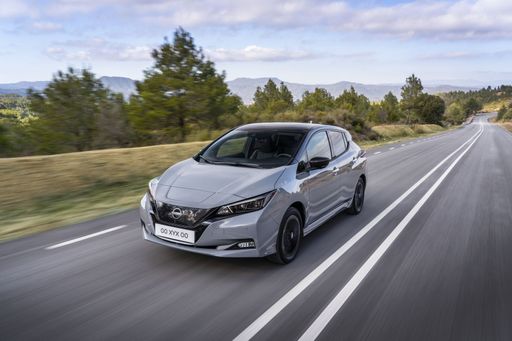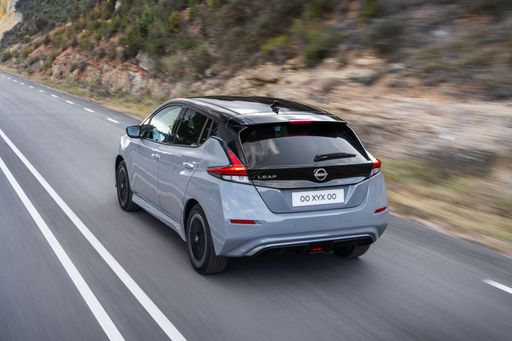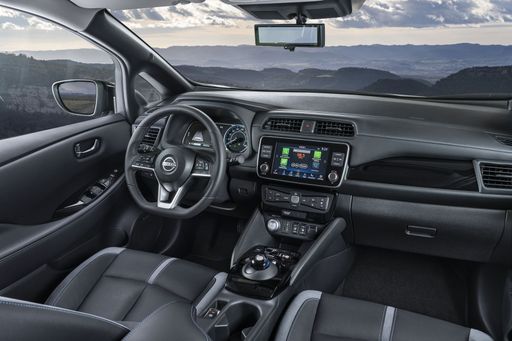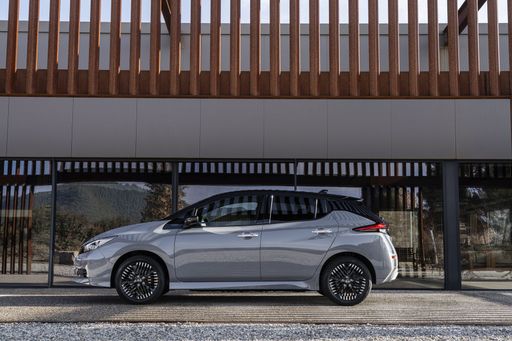Nissan Leaf VS Ferrari 296 Roadster – Specs, Efficiency & Price Comparison
Which model is the better choice – the Nissan Leaf or the Ferrari 296 Roadster? We compare performance (217 HP vs 830 HP), boot capacity (394 L vs 0 L), efficiency (16.70 kWh vs 7.40 L), and of course, the price (30800 £ vs 266200 £).
Find out now which car fits your needs better!
The Nissan Leaf (Hatchback) is powered by a Electric engine and comes with a Automatic transmission. In comparison, the Ferrari 296 Roadster (Roadster) features a Plugin Hybrid engine and a Automatic gearbox.
When it comes to boot capacity, the Nissan Leaf offers 394 L, while the Ferrari 296 Roadster provides 0 L – depending on what matters most to you. If you’re looking for more power, you’ll need to decide whether the 217 HP of the Nissan Leaf or the 830 HP of the Ferrari 296 Roadster suits your needs better.
There are also differences in efficiency: 16.70 kWh vs 7.40 L. In terms of price, the Nissan Leaf starts at 30800 £, while the Ferrari 296 Roadster is available from 266200 £.
Compare all the key specs now and find out which model fits your lifestyle best!
Nissan Leaf
The Nissan Leaf stands out as a pioneering model in the realm of electric vehicles, known for its impressive blend of practicality and eco-friendliness. It offers a smooth and quiet driving experience, making it an ideal choice for city commuting and longer journeys alike. The interior design is both comfortable and intuitive, providing drivers with a sense of modernity and ease of use.
details @ germany.nissannews.com
@ germany.nissannews.com
 @ germany.nissannews.com
@ germany.nissannews.com
 @ germany.nissannews.com
@ germany.nissannews.com
 @ germany.nissannews.com
@ germany.nissannews.com
Ferrari 296 Roadster
The Ferrari 296 Roadster is a striking addition to the brand's esteemed lineup, offering an exhilarating blend of performance and style. Designed with an emphasis on driving pleasure, this open-top marvel delivers an engaging experience enhanced by its agile handling and responsive dynamics. Its sleek, aerodynamic contours and luxurious interior materials reflect Ferrari's unwavering commitment to craftsmanship and innovation.
details

|
|
|
|
|
Costs and Consumption |
|
|---|---|
|
Price
30800 - 37200 £
|
Price
266200 £
|
|
Consumption L/100km
-
|
Consumption L/100km
7.40 L
|
|
Consumption kWh/100km
16.7 - 17.8 kWh
|
Consumption kWh/100km
-
|
|
Electric Range
270 - 385 km
|
Electric Range
25 km
|
|
Battery Capacity
39 - 59 kWh
|
Battery Capacity
-
|
|
co2
0 g/km
|
co2
169 g/km
|
|
Fuel tank capacity
-
|
Fuel tank capacity
65 L
|
Dimensions and Body |
|
|---|---|
|
Body Type
Hatchback
|
Body Type
Roadster
|
|
Seats
5
|
Seats
2
|
|
Doors
5
|
Doors
2
|
|
Curb weight
1580 - 1756 kg
|
Curb weight
1540 kg
|
|
Trunk capacity
385 - 394 L
|
Trunk capacity
0 L
|
|
Length
4490 mm
|
Length
4565 mm
|
|
Width
1788 mm
|
Width
1958 mm
|
|
Height
1540 - 1545 mm
|
Height
1191 mm
|
|
Payload
384 - 415 kg
|
Payload
412 kg
|
Engine and Performance |
|
|---|---|
|
Engine Type
Electric
|
Engine Type
Plugin Hybrid
|
|
Transmission
Automatic
|
Transmission
Automatic
|
|
Transmission Detail
Reduction Gearbox
|
Transmission Detail
Automat. Schaltgetriebe (Doppelkupplung)
|
|
Drive Type
Front-Wheel Drive
|
Drive Type
Rear-Wheel Drive
|
|
Power HP
150 - 217 HP
|
Power HP
830 HP
|
|
Acceleration 0-100km/h
6.9 - 7.9 s
|
Acceleration 0-100km/h
2.90 s
|
|
Max Speed
144 - 157 km/h
|
Max Speed
330 km/h
|
|
Torque
320 - 340 Nm
|
Torque
740 Nm
|
|
Number of Cylinders
-
|
Number of Cylinders
6
|
|
Power kW
110 - 160 kW
|
Power kW
610 kW
|
|
Engine capacity
-
|
Engine capacity
2992 cm3
|
General |
|
|---|---|
|
Model Year
2019
|
Model Year
2022
|
|
CO2 Efficiency Class
A
|
CO2 Efficiency Class
F
|
|
Brand
Nissan
|
Brand
Ferrari
|
Nissan Leaf
Introduction to the Nissan Leaf: A Pioneer in Electric Mobility
The Nissan Leaf has established itself as a trailblazer in the realm of electric vehicles (EVs) since its launch. As we delve into its present-day iterations, the Leaf continues to soar in popularity due to remarkable advancements in technology and sustainability. Let's explore what makes the Nissan Leaf a standout in today's automotive market.
Power and Performance: Under the Hood of the Nissan Leaf
The Nissan Leaf boasts a power output ranging from 150 to 217 PS, depending on the battery option chosen. The vehicle's electric motor, a product of cutting-edge engineering, offers instant torque ranging from 320 to 340 Nm, resulting in impressive acceleration capabilities. The 0 to 100 km/h dash is achieved in as little as 6.9 seconds, showcasing its prowess in electric performance.
Battery Technology: Efficient Energy Management
When discussing the Nissan Leaf, battery technology is at the forefront. The available battery capacities range from 39 to 59 kWh, supporting an electric range between 270 to 385 km. This flexibility allows drivers to choose a model that best fits their driving habits, providing peace of mind for longer journeys without frequent recharging.
Sustainability: The Environmental Edge
One of the primary attractions of the Nissan Leaf is its commitment to sustainability. As an all-electric vehicle, it produces zero CO2 emissions, placing it in the top tier of the CO2-efficiency class with an 'A' rating. This clean energy approach contributes significantly to reducing environmental impact and supports Nissan's drive towards a greener future.
Design and Comfort: Aesthetic Appeal and Practicality
The Nissan Leaf is not just about efficiency; it's also designed for comfort and utility. With its sleek hatchback body and dimensions of 4490 mm in length, 1788 mm in width, and a height of up to 1545 mm, it offers ample interior space. The boot capacity ranges from 385 to 394 litres, providing sufficient storage for everyday needs. The model accommodates five passengers comfortably, ensuring a pleasant ride for everyone.
Innovations and Safety: Advanced Features for Peace of Mind
Nissan equips the Leaf with an array of intelligent features that enhance safety and convenience. The available equipment lines, including N-CONNECTA, Tekna, e+ N-CONNECTA, and e+ Tekna, offer varying levels of technology integration. ProPILOT Assist, e-Pedal, and a comprehensive suite of driver-assistance technology are just a few examples that highlight Nissan's commitment to innovation in the EV market.
Conclusion: The Nissan Leaf Continues to Lead
With prices ranging from €35,900 to €43,400, the Nissan Leaf remains an attractive choice for those looking to embrace electric mobility. It perfectly balances performance, design, and sustainability, making it a compelling choice in the competitive EV landscape. The Nissan Leaf not only represents the future of driving but also reinforces why it continues to be a leader in the electric vehicle community.
Ferrari 296 Roadster
Experience the Thrill: The New Ferrari 296 Roadster
The Ferrari 296 Roadster is a symbol of elegance and power, representing the pinnacle of Ferrari's automotive engineering. This formidable beast on wheels masterfully combines stunning design with innovative hybrid technology, encapsulating the future of sports cars.
Design and Engineering Excellence
From its striking exterior curves to its plush interiors, the Ferrari 296 Roadster is a testament to Ferrari’s rich heritage in car design innovation. Featuring a compact yet aerodynamic body, the car measures 4,565 mm in length, 1,958 mm in width, and stands 1,191 mm tall. These dimensions give the Roadster an aggressive stance while enhancing its on-road performance.
The seating capacity is strategically limited to two, ensuring a focused, immersive driving experience that keeps tradition alive in modern form.
Powertrain and Performance
Under the sleek hood, the 296 Roadster houses a potent 2992 cm³ V6 engine, coupled with a state-of-the-art Plug-in Hybrid Electric Vehicle (PHEV) system. Together, they deliver an astonishing output of 830 PS (610 kW), demonstrating an outstanding blend of power and efficiency.
The car’s acceleration from 0-100 km/h is a mere 2.9 seconds, propelled by robust torque of 740 Nm. The maximum speed peaks at 330 km/h, ensuring thrill-seekers are not left wanting. The automated dual-clutch transmission, an F1-inspired feature, makes every gear shift smooth and precise.
Efficiency Meets Innovation
Despite its raw power, the Ferrari 296 Roadster remains commendably efficient. It has a fuel consumption rate of 7.4 L/100 km, supported by a slight 25 km electric-only range, reducing its carbon footprint slightly at 169 g/km CO2 emissions.
This efficiency, matched with its high-performance credentials, illustrates Ferrari’s commitment to the hybrid revolution while preserving the thrilling essence of driving.
Pricing and Market Position
The Ferrari 296 Roadster, with a starting price of 310,595 €, secures its stance as a luxury item for the discerning enthusiast. This price tag reflects the advanced engineering and the seamless fusion of luxury and technology.
Conclusion: A New Era for Ferrari
In conclusion, the Ferrari 296 Roadster is more than just a sports car; it is an experience, an epitome of engineering and luxury. Its blend of power and efficiency represents a bold step forward in the high-performance segment, heralding a new era of hybrid supercars that do not compromise on the driving excitement Ferrari is known for.
The prices and data displayed are estimates based on German list prices and may vary by country. This information is not legally binding.
